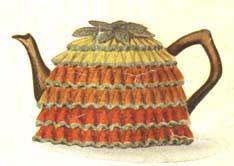
Always an acceptable gift this cosy would be a delight to the lucky recipient.
There is scope too for individuality in the color scheme. If desired it may be carried out in one color, with edgings of
contrasting, or, a charming idea is to commence at the lower edge with a darker shade, and work each of four succeeding lines of daffodil pattern in a shade lighter,
i.e. The lower line, Orange, 2nd line, Burnt Orange, 3rd line, Gold, 4th line Daffodil Yellow, 5th line Primrose, edging each line with one row of green, and finishing the top with green. The following directions are for a five-cup tea-pot.
Should a larger or smaller cosy be required, add or subtract 13 stitches for every 1/2 inch larger or smaller in circumference. The cosy is worked in two halves, and is finished at top with a cluster of green leaves.
Materials
For cosy in one color with contrasting edges, 2 oz. 4-ply with 1/2 oz. contrasting for edges and leaves at top (Note from Sarah: Australian 4 ply is fingering weight)
For cosy with five colors–five 1/2 oz. skeins of 4-ply, with 1/2 oz. of contrasting for edges and leaves at top
1 pair Old UK Size No. 11 knitting needles.
Pattern
Commencing at lower edge cast on 159 stitches in green (or color used for edging the lines of daffodils). Break off and join in main color.
Work as follows:
1st Row: * P3, K10, repeat from * throughout ending P3.
2nd Row: K3, * P10, K3, repeat from *.
3rd Row: * P3, K2 tog., K6, K2 tog., repeat from *, ending P3.
4th Row: K3,. * P8, K3; repeat from *.
5th Row: * P3, K2 tog., K4, K2 tog., repeat from *, ending P3.
6th Row: K3, * P6, K3; repeat from *.
7th Row: * P3, K2 tog., K2, K2 tog., repeat from *, ending P3.
8th Row: K3, * P4, K3; repeat from *.
9th Row: * P3, K2 tog., K2 tog.; repeat from *, ending P3.
10th Row: K3, * P2, K3; repeat from *.
11th Row: * P3, K2 tog.; repeat from *, ending P.3.
12th Row: K3, *P1, K3, repeat from *.
13th Row: * P2, P2 tog, (of which 1 is a purl st. and 1 a knit st.); repeat
from *, ending P3.
14th Row: Knit. These 14 rows make 1 line of daffodil stitch. Break off.
Join in green for second line of daffodils.
Next Row: * K3. Cast on 10 stitches *. Repeat from * to * to end of row (159 stitches).
Break off green and join in main color.
Repeat from 2nd to 14th row.
Continue in this manner until 5 rows of daffodils are worked, (or required depth), then cast off as follows: * slip 1, knit 2 tog., pass slip st. over *.
Repeat to end of row. Work another side to correspond.
Neaten the ends and sew together, allowing openings for spout and handle.
Draw top in a little and finish with cluster of green leaves.
To Knit Leaf:
Cast on 1 stitch and knit in garter stitch as follows:
1st, 2nd, 3rd, 4th and 5th rows, K twice into 1st then knit straight on 6 stitches for 10 rows.
In next 5 rows decrease by knitting first 2 stitches together.
Work about 8 leaves and arrange in pretty cluster at top
If a lining is desired cast on 50 stitches and knit in garter stitch for depth of 4 lines of daffodils, then decrease by knitting 2 stitches together in every second row at three regular intervals for the remainder.
Cast off.
Knit corresponding side and slip stitch inside of cosy.
This pattern is in the public domain. Digital version copyright © Sarah Bradberry 2002. Kindly transcribed for Knitting-and.com by Dena Cherenson
